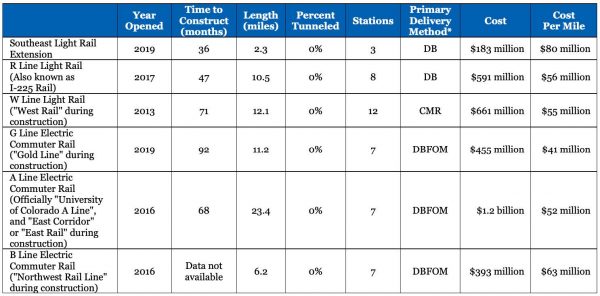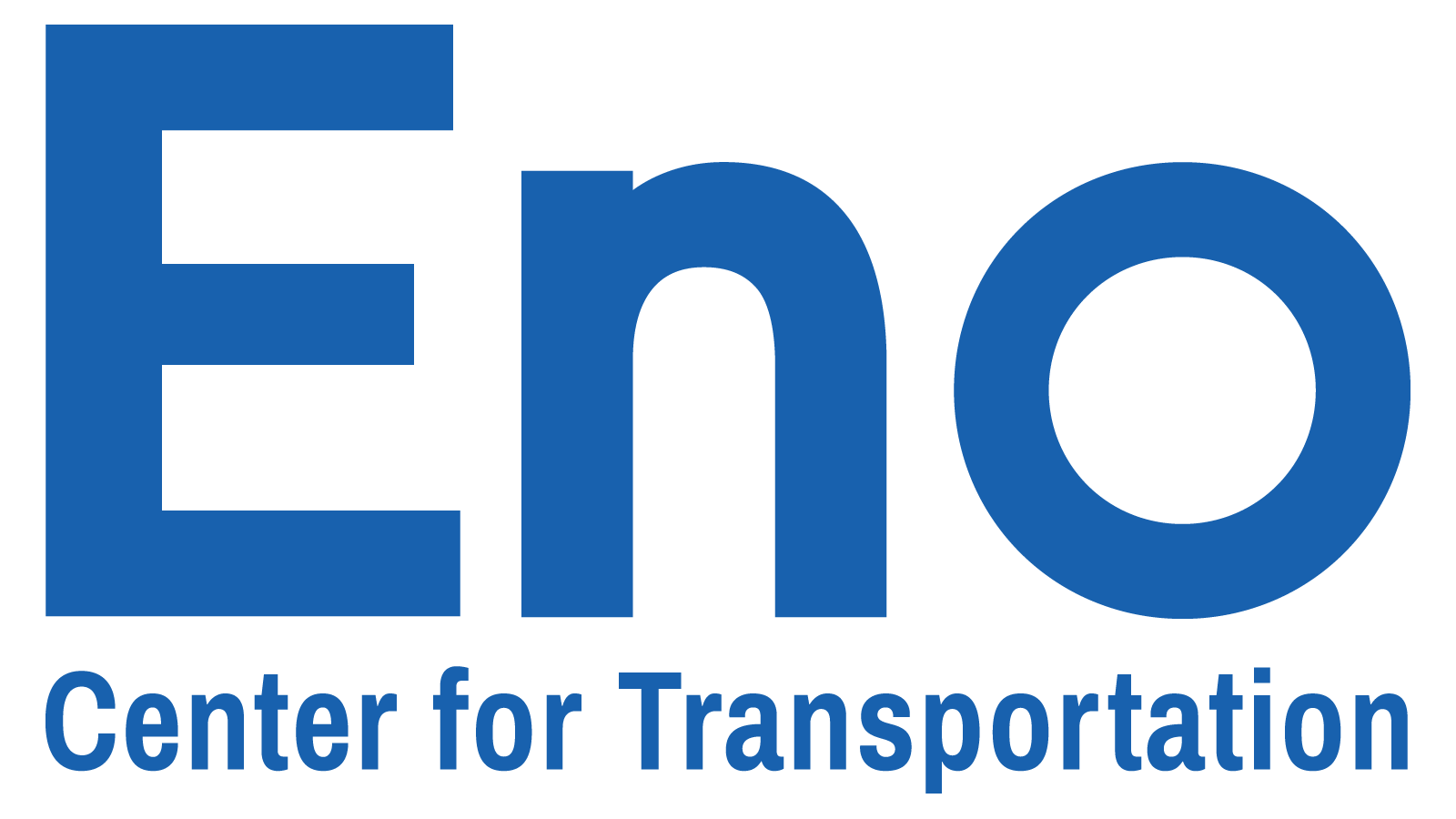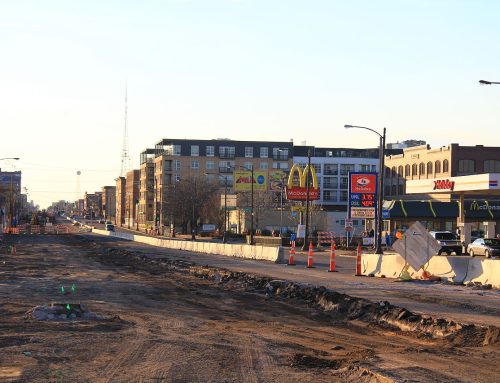Denver
Denver’s first light rail project (the D Line) opened in 1994, and two major regional investments since then have significantly expanded the system. The first was the Transportation Expansion Project (T-REX), which added 19 miles of track and 13 stations to the region’s light rail system, and the second was FasTracks, which added 25 miles of light rail track and 53 miles of commuter rail to the system. All of the projects discussed in this case study are part of the FasTracks initiative due to their recency and because a portion of the initiative was the first major rail construction project in the United States to use a public-private partnership delivery method. However, both T-REX and FasTracks showcase relatively low construction costs for U.S. rail projects, and the early success of T-REX established momentum for the buildout of FasTracks several years later.
Table of Contents
Governance Overview
Denver’s Regional Transportation District (RTD) was established in 1969 by the Colorado General Assembly. The agency serves over 3 million people located within 2,342 square miles and provides service in eight of the twelve counties of the Denver- Aurora-Boulder Combined Statistical Area. Services include bus, rail, shuttles, ADA paratransit services, demand responsive services, special event services, and vanpools. RTD is governed by a 15-member, publicly elected board of directors. Each of these members is elected to a four-year term and represents a specific district of roughly 180,000 constituents with varying degrees of density. The board has influence over issues like bus service planning but relatively less over rail capital project delivery.
The region’s MPO, the Denver Regional Council of Governments (DRCOG) approves financial plans and vehicle technology for RTD rapid transit projects. The Colorado Department of Transportation (CDOT) coordinates with DRCOG and RTD to coordinate and administer funding from the state to rail projects. CDOT and RTD partner to coordinate construction for rail infrastructure that crosses state or federal highways and co-produce the relevant EIS.
RTD also coordinates with local governments and private entities for ROW. For example, the University of Colorado A Line crosses ROW belonging to the Union Pacific Railroad, private property, the shared city and county of Denver, and the city of Aurora.373 The agency must also coordinate with private utility companies for ROW.
System Overview
TABLE 10: TRANSIT LINES PROFILED IN THE DENVER REGION

*A single delivery method is not always used on an entire project.
The region currently has four commuter rail lines (University of Colorado A Line; B; G; N) powered by overhead electric lines and seven light rail lin es (C; D; E; F; H; L; R; W).374 Commuter rail was introduced with the University of Colorado A Line in April 2016. All of the lines in Denver’s system are at-grade or elevated, and there was no major tunneling required for construction. As a result, RTD avoided some of the physical construction and engineering challenges of other regions. Additionally, much of the rail construction is through highway medians or existing freight ROW, simplifying the construction process.
Across all projects, local sales tax bonds and federal grants were the primary sources of funding. Additional funding sources and an increase in federal grants received added $900 million to the funding committed to the capital buildout of FasTracks through 2020.375
In 2007 the FTA selected three FasTracks lines—the East Rail, the G Line, and the first segment of the B Line to Westminster—for federal funding through the Public-Private Partnership Pilot Program (Penta-P). These three projects (along with a commuter rail maintenance facility) eventually became known as the Eagle P3. In 2011, the Eagle P3 received a $1.03 billion FFGA from the FTA and $486 million in private financing and RTD sales taxes. The agency refers to this funding model as the “Three-legged Financing Stool.”
FIGURE 14: FASTRACKS PROJECT FUNDING COMPARISON BY SOURCE

Note: Adapted from information found in RTD’s FasTracks Program Overview Executive Summary from June 29, 2018.
The chart compares the original 2004 funding plan to the actual and committed funding through 2020 as stated in the 2017 Annual Program Evaluation.
Effective project management helps move projects forward.
The completion of the T-REX program ahead of schedule and under budget helped increase public support for FasTracks several years later.376 T-REX was an RTD/ CDOT joint effort which allowed the project to benefit from existing institutional capacity at CDOT. For example, the ROW acquisition process used in-house CDOT appraisers and existing CDOT ROW forms.377 T-REX was also a successful example of DB project delivery, in part attributed to bidder input on the contract to identify potential cost drivers and on the use of experts with experience in the legal aspects of DB work. Projects that predated FasTracks had minimal overlap in the timing of the environmental review process, which allowed RTD staff to focus attention on the various phases of project delivery in sequence. During FasTracks, staff were simultaneously carrying out various phases of project delivery and managing different consultants across multiple projects.378 FasTracks was projected to be completed in 2017 at an estimated cost of $4.7 billion. However, the project is still underway and projected costs have risen to $5.2 billion as of 2020.379
Because RTD used a range of procurement methods across FasTrack’s various projects, having strong leadership and delegated decision-making helped to keep projects moving forward and frequent reflection through lessons learned documents enabled the agency to learn from its missteps. RTD filled senior and key staff management positions with professionals that were highly-experienced in P3s.380 RTD also created separate project management positions for planning and engineering. This was particularly beneficial in allowing both perspectives to contribute to the environmental review process, and encouraging both managers to benefit from each other’s expertise on technical or planning issues.
As part of FasTracks, RTD also adopted a delegated authority approach for management, which allowed major decisions to be approved by designated managers rather than going through a chain of command (i.e. approval by all levels of managers within the organization). This delegated authority approach led to faster turnarounds on key decisions and thus fewer project delays, though this approach is rare. In addition, change orders did not require board approval unless the amount exceeded the overall project budget. This practice, in place since the T-REX project, enabled quick decision making and expedited the work.
In its post-completion evaluation of FasTracks, RTD indicated that several project delivery models were used on FasTracks projects, a departure from the agency’s original plan to use DBB for all corridors.381 The evaluation found that the DB method used for the Southeast Rail Extension and N Line and DBFOM used for the Eagle P3 maximized contractor innovation and helped the projects get completed faster. The CM/GC method used for the W Line required early buy-in from RTD as the designer, but in practice RTD and the contractor were not always in agreement about project details. This may have been a side effect of these entities working in separate locations and on different contracts. RTD also indicated that the negotiations for this contract were challenging and that “there is no substitute for the discipline of the marketplace under a competitive bidding environment.” For its part, DBB was found to be best used for smaller projects or those that involve high levels of risk.
Just after the FasTracks vote but before construction was set to begin, RTD realized that revenues would be lower than originally anticipated due to declining sales tax revenues as a result of the economic recession, and that a P3 may also make it easier to deliver multiple corridors at once.382 In 2009, RTD issued a request for proposals and later entered into a 34-year agreement with Denver Transit Partners (DTP), for which it agreed to pay DTP to operate and maintain the system.383 By using this approach, RTD let the private partner determine how to bundle the most valuable lines together, which allowed the Eagle P3 projects to be delivered faster as a result, though they were not without implementation and operations challenges later on.
Transit P3s can expedite delivery, but if not structured carefully they can cause problems in the future.
The use of a P3 approach can also alleviate some of the schedule constraints under a DBB procurement. Project owners retain a higher degree of control under DBB, which can require multiple procurements and handoffs between the design and construction contractors, potentially slowing progress. On the other hand, P3 models transfer much of the control over project details to the private consortium, which may help expedite procurement and delivery.
Much of a project’s risk is inherently transferred to the private sector with a P3, but project sponsors must still do their due diligence to understand the level of risk transfer and provide proper oversight. Since the Eagle P3 was the first full DBFOM public-private partnership for transit in the United States, there were many processes for which RTD had little prior experience or lessons to gather from peer projects and the agency took many steps to have pre-construction meetings with stakeholders like vendors, financiers, and railcar providers to get a better understanding of the project’s risk. While some risk was transferred to the private sector for the Eagle P3 project, responsibility for other elements like compliance with railroad regulations and design changes were less clear and more risk could have been transferred to the private sector.
The concession agreement with the selected P3 entity resulted in capital costs that were over $300 million less than RTD’s estimate.384 This savings enabled RTD to jump start other projects. Since project specifications were largely performance based (rather than prescriptive), the concessionaire was able to balance the risk of project design elements against the long-term operation.385 The concession agreement specified a 29-year operating agreement, over which availability payments would be made to the concessionaire, partially based on operational performance parameters during that period.386
Therefore, in its bid, the concessionaire performed numerous life-cycle, cost-benefit analyses to determine whether specific capital items would impact operational performance and thus risk future availability payments. In some cases, elements such as double tracking and additional crossovers were determined not to provide a positive cost-benefit ratio and were deleted. In others, items such as the incorporation of a redundant substation were retained.
This analysis of cost and benefits performed by the concessionaire when preparing their bid, was significantly more extensive than anything typically done by project owners who tend to use long standing criteria and personal experiences of project personal and consultants.
The Eagle P3 project had a formal process in place for design criteria conformance in which review and approval of checklists by Safety and Security Working Groups produced a Certificate of Conformance for each project segment, but RTD stated that the process “was not always scheduled in a timely manner” and in some instances, that resulted in construction beginning prior to completion of that process, which resulted in cost and schedule overruns. Ultimately, any delays or cost increases were risks borne by the contractor, though RTD was responsible for reviewing project schedules and milestones to verify that various activities are included in Design Criteria Conformance Checklists.387
RTD oversight of design reviews for structures could have been improved, given that a number of bridge structure deficiencies arose, requiring the demolition and re-design of one bridge, two bridge deck retrofits, and other structural changes like girder replacements. According to the agency, the structures design oversight team should have identified unique or challenging design elements and ensured that the design engineers understood the relevant codes during the design review phase, rather than focusing only on contract compliance. 388 However, because RTD used the P3 delivery model, the concessionaire performed the necessary structural modifications without any cost impacts to the agency.
Among the lessons learned, RTD determined that a strong legal and financial counsel team was a necessary component of a P3 since “it is at the core a business deal rather than a traditional construction contract.”.389 Some contractors are increasingly reluctant to accept public rail projects due to the potential risk involved. If they do pursue projects, their bid prices incorporate significant contingencies. From RTD’s perspective, construction companies’ legal teams and strategies have grown over time. One interviewee expressed that “rather than doing business with a construction company that occasionally experiences legal issues, the transit agency is doing business with a legal firm with a construction wing,” since there is a robust legal strategy built into construction companies’ business because of increasing project complexity and the risk of litigation.
Coordinating with third-party entities can create challenges.
In numerous instances across the FasTracks projects, challenges involving third parties—such as federal regulators, local jurisdictions, and utility companies—surfaced that were not accounted for in the original contract negotiations.
For example, RTD experienced challenges getting approvals from local governments on the North Metro project. Interviewees expressed that local jurisdictions see the rail construction process as a way to extract upgrades to other adjacent infrastructure that jurisdictions may not be able to pay for due to local budget limitations. These can include upgrades to drainage infrastructure, streets, and other elements that extend beyond the project’s scope. Since the local jurisdictions cannot see the fully completed designs in a DB contract, they may request more change orders than they otherwise would have. For example, for North Metro, RTD tried to streamline the design-review process in inter-governmental agreements, but differing processes within a jurisdiction (e.g. between the design and planning entities and the public works entity) sometimes created situations where certain departments were aware of design plans and others were not. In some cases, this dynamic led to change orders and finger-pointing.
Similarly, contracts do not always account for ambiguous regulatory practice. The P3 approach for the Eagle P3 projects allowed RTD to shift significant risk to the private sector, but there was a “legal gray area” when complications arose concerning compliance with freight rail regulations. RTD was the first transit agency to deploy positive train control (PTC) technology during construction of FasTracks.390 PTC refers to technologies that automatically stop trains before collisions and incidents occur. PTC was part of the original designs for the Eagle P3, which was viewed as an innovative aspect of the project, but one that resulted in confusion about risk and responsibility when regulatory challenges arose.
Because RTD’s commuter rail lines were designed to operate using electrified service, the traditional form of crossing gate warnings was not available. In early agreements, it was decided that PTC would include some technologies that could provide constant warning times. Federal Railroad Administration (FRA) regulations vaguely state that any “electromagnetic, electronic, or electrical” device at each crossing warning system be maintained in accordance with the system’s limits for any warning system apparatus.391 As for gate arms, regulations state that gates should close no less than three seconds after flashing lights appear and remain positioned no less than five seconds prior to any train.392
Once testing began, the Colorado Public Utilities Commission and FRA were not satisfied with the warning times, but did not have a specific regulation to challenge, as the design followed industry standards. After the University of Colorado A Line was opened for service a software glitch in the at-grade safety gates at vehicle crossings caused the gates to open and close at static times that did not account for potential train delays or early arrivals.393 This error required the agency to operate under a waiver from the FRA.394
The regulators’ primary experience prior to this project had been on rural freight projects, and there was general agreement across all stakeholders—including the regulators, RTD, and DTP—that the regulation of crossing gates for passenger rail in an urban setting was uncharted territory. Under current FRA policy in Section 255, a minimum of 20 seconds is required for grade crossing warning systems to signal an oncoming train, however no maximum number has been imposed.395
RTD’s contract indicated that the agency was responsible for regulatory compliance, since they are the Railroad of Record. However, the lack of clarity over interpretation of the regulation ultimately left DTP responsible for additional costs incurred, as they were the concessionaire for the Eagle P3 and RTD believed they would comply with the regulations. The proposed solution while the issue was sorted out was to deploy crossing gate guards (“flaggers”) at each gate on the University of Colorado A and G lines.396 DTP filed a lawsuit for $122 million for the cost of crossing guards, and RTD filed a countersuit of $120 million for bridges that were not designed to the proper standard and had to be rebuilt, which left less time for testing of crossing gates.397
This issue does highlight a somewhat unique regulatory risk with rail transit projects. These projects generally require the final approval of some independent regulatory body before service can commence. The risk allocation for this factor and how much contractors would apply to this risk (if so allocated) is an important consideration.
RTD also experienced challenges with water and utility regulators and operators. Water management policies in the intermountain west have created the notion that “water is king” which presents challenges for major projects whose alignments run next to water infrastructure. In the case of the North Metro line, the project is adjacent to a large wastewater treatment plant, crosses the Platte River three times, and parallels an irrigation canal. Acquiring land from the entities that manage these assets was a challenge and ultimately, RTD negotiated five major agreements with third parties that were not originally in place when they issued the notice to proceed to contractors.
Further issues arose when coordinating utility relocation. RTD was the party of record in agreements with utility companies, and the agency considered coordination with utilities as an area that needs improvement. Despite RTD being the party of record, there was originally no clear delineation of who—RTD or DTP—would provide reports on testing activities to utility companies. For example, reports of a breaker tripping were never reported to Xcel Energy, which strained relationships between RTD, DTP, and Xcel Energy. As a result, RTD indicated that rather than relying on contractors to provide utility companies with reports of test activities, the agency itself should be responsible for these notifications as the party of record.398
Early coordination between internal and external stakeholders can help to mitigate unanticipated challenges. Bringing entities that are not directly party to the contract but that are otherwise affected by a project into negotiations sooner rather than later can avoid delays or costly changes later in the project.




